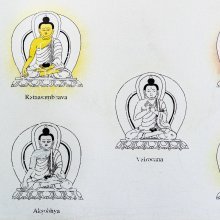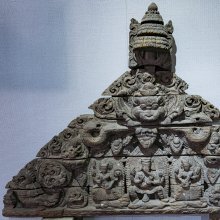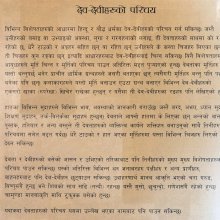Akriti, Ākṛtī, Ākṛti: 25 definitions
Introduction:
Akriti means something in Buddhism, Pali, Hinduism, Sanskrit, the history of ancient India, Marathi, Hindi. If you want to know the exact meaning, history, etymology or English translation of this term then check out the descriptions on this page. Add your comment or reference to a book if you want to contribute to this summary article.
The Sanskrit terms Ākṛtī and Ākṛti can be transliterated into English as Akrti or Akriti, using the IAST transliteration scheme (?).
Alternative spellings of this word include Akrati.
Images (photo gallery)
In Hinduism
Ayurveda (science of life)
Source: Wisdom Library: Āyurveda and botanyĀkṛti (आकृति) is a Sanskrit technical term, translating to the “physical charactereistics” of a plant (e.g. shape). It is used throughout Ayurvedic literature such as the Suśruta-saṃhitā and the Caraka-saṃhitā.

Āyurveda (आयुर्वेद, ayurveda) is a branch of Indian science dealing with medicine, herbalism, taxology, anatomy, surgery, alchemy and related topics. Traditional practice of Āyurveda in ancient India dates back to at least the first millenium BC. Literature is commonly written in Sanskrit using various poetic metres.
Purana and Itihasa (epic history)
Source: archive.org: Puranic EncyclopediaĀkṛti (आकृति).—A king of ancient Bhārata. This king ruled over the land of Saurāṣṭra. (Śloka 61, Chapter 31, Sabhā Parva, Mahābhārata).
Source: archive.org: Shiva Purana - English TranslationĀkṛti (आकृति) refers to a “(human) form”, according to the Śivapurāṇa 2.3.30 (“The Celebration of Pārvatī’s Return”).—Accordingly, as Brahmā narrated to Nārada: “[...] In the meantime the lord of mountains returned from the Gaṅgā. He saw the mendicant in the human form (nara-ākṛti) in his court-yard. On hearing the details from Menā he became very angry. He ordered his attendants to drive out the dancer. But, O excellent sage, none of them could push him out as he was hot to the touch like a blazing fire and very brilliant. [...]”.
Source: Cologne Digital Sanskrit Dictionaries: The Purana Index1a) Ākṛti (आकृति).—A progenitor, responsible for form and shape.*
- * Brahmāṇḍa-purāṇa II. 9. 1 and 7.
1b) A son of Babhru.*
- * Brahmāṇḍa-purāṇa III. 70. 38.

The Purana (पुराण, purāṇas) refers to Sanskrit literature preserving ancient India’s vast cultural history, including historical legends, religious ceremonies, various arts and sciences. The eighteen mahapuranas total over 400,000 shlokas (metrical couplets) and date to at least several centuries BCE.
Natyashastra (theatrics and dramaturgy)
Source: Wisdom Library: Nāṭya-śāstraĀkṛtī (आकृती) refers to a class of rhythm-type (chandas) containing twenty-two syllables in a pāda (‘foot’ or ‘quarter-verse’), according to the Nāṭyaśāstra chapter 15. There are twenty-six classes of chandas and out of them arise the various syllabic meters (vṛtta), composed of four pādas, defining the pattern of alternating light and heavy syllables.

Natyashastra (नाट्यशास्त्र, nāṭyaśāstra) refers to both the ancient Indian tradition (shastra) of performing arts, (natya—theatrics, drama, dance, music), as well as the name of a Sanskrit work dealing with these subjects. It also teaches the rules for composing Dramatic plays (nataka), construction and performance of Theater, and Poetic works (kavya).
Vyakarana (Sanskrit grammar)
Source: Wikisource: A dictionary of Sanskrit grammarĀkṛti (आकृति).—lit. form; individual thing; cf. एकस्या आकृतेश्चरितः प्रयोगो द्वितीयस्यास्तृतीय-स्याश्च न भवति (ekasyā ākṛteścaritaḥ prayogo dvitīyasyāstṛtīya-syāśca na bhavati) M.Bh on III.1.40 Vārt.6. The word is derived as आक्रियते सा आकृतिः (ākriyate sā ākṛtiḥ) and explained as संस्थानम् (saṃsthānam); cf. आक्रियते व्यज्यते अनया इति आकृतिः संस्थानमुच्यते (ākriyate vyajyate anayā iti ākṛtiḥ saṃsthānamucyate) Nyāsa on IV.1.63; (2) general form which, in a way, is equivalent to the generic notion or genus; cf. आकृत्युपदेशात्सिद्धम् । अवर्णा-कृतिरुपदिष्टा सर्वमवर्णकुलं ग्रहीष्यति (ākṛtyupadeśātsiddham | avarṇā-kṛtirupadiṣṭā sarvamavarṇakulaṃ grahīṣyati) M. Bh. I.1 Āhn. 1; (3) notion of genus; cf also यत्तर्हि तद् भिन्नेष्वभिन्नं छिनेष्वच्छिन्नं सामान्यभूतं स शब्दः । नेत्याह । आकृतिर्नाम सा (yattarhi tad bhinneṣvabhinnaṃ chineṣvacchinnaṃ sāmānyabhūtaṃ sa śabdaḥ | netyāha | ākṛtirnāma sā). M. Bh. I.1.Āhn.1; (4) a metre consisting of 88 letters; cf. R. Prāt. XVI.56,57.

Vyakarana (व्याकरण, vyākaraṇa) refers to Sanskrit grammar and represents one of the six additional sciences (vedanga) to be studied along with the Vedas. Vyakarana concerns itself with the rules of Sanskrit grammar and linguistic analysis in order to establish the correct context of words and sentences.
Chandas (prosody, study of Sanskrit metres)
Source: Shodhganga: a concise history of Sanskrit Chanda literatureĀkṛti (आकृति) is one of the twenty-six varieties of Sanskrit metres (chandas) mentioned in the Chandaśśāstra 1.15-19. There are 26 Vedic metres starting with 1 to 26 letters in each pāda. It is a common belief that the classical metres are developed from these 26 metres. Generally a metre has a specific name according to it’s number of syllables (akṣara). But sometimes the same stanza is called by the name of another metre from the point of view of the pādas.

Chandas (छन्दस्) refers to Sanskrit prosody and represents one of the six Vedangas (auxiliary disciplines belonging to the study of the Vedas). The science of prosody (chandas-shastra) focusses on the study of the poetic meters such as the commonly known twenty-six metres mentioned by Pingalas.
Shaktism (Shakta philosophy)
Source: Google Books: ManthanabhairavatantramĀkṛti (आकृति) refers to a “form” (e.g., vikaṭākṛti—‘one’s furious form’), according to the Kularatnoddyota, one of the earliest Kubjikā Tantras.—Accordingly, “That, O goddess, is said to be the subtle (form), now listen to the gross one. [...] The great conch (she holds) makes her proud and the beauty of her crown enhances her beauty. (She is) adorned with a garland of severed heads that extends from the soles of the feet up to (her) neck. She drips with the blood that flows (from the heads) and is fatigued by the weight of her (dangling) rocking hair. Very fierce, she destroys (the universe) by licking (it up). She has big teeth and a thin stomach. She has long (dangling) breasts and a large chest. Her furious form [i.e., vikaṭa-ākṛti] is (lean) without flesh. She has six faces and twelve arms and her back is slightly bent”.
Source: Brill: Śaivism and the Tantric Traditions (shaktism)Ākṛti (आकृति) refers to “one’s appearance”, according to the King Vatsarāja’s Pūjāstuti called the Kāmasiddhistuti (also Vāmakeśvarīstuti), guiding one through the worship of the Goddess Nityā.—Accordingly, “[...] I venerate all [ten] Kuleśvarīs, starting with Sarvasampatpradā, the goddesses of the external ring of ten. They are auspicious and display the gestures of boon-giving and safety. I resort to Sarvajñā and other goddesses situated in the internal ring of ten. They carry a rosary and a book [in their hands], and their appearance is charming like camphor (karpūra-rucira-ākṛti). [...]”.

Shakta (शाक्त, śākta) or Shaktism (śāktism) represents a tradition of Hinduism where the Goddess (Devi) is revered and worshipped. Shakta literature includes a range of scriptures, including various Agamas and Tantras, although its roots may be traced back to the Vedas.
Sports, Arts and Entertainment (wordly enjoyments)
Source: archive.org: Syainika Sastra of Rudradeva with English Translation (art)Ākṛti (आकृति) refers to “form” or “composition” (of a specific class of Hawks), according to the Śyainika-śāstra: a Sanskrit treatise dealing with the divisions and benefits of Hunting and Hawking, written by Rājā Rudradeva (or Candradeva) in possibly the 13th century.—Accordingly, [while discussing the yellow-eyed division of hawks]: “The Vājas are of five kinds. Their descriptions are given separately. The class called Balākā is slender in its make (kṛśa-ākṛti), with white and black feathers (?) on the breast and on the thighs. It is easily tamed. [...]”.

This section covers the skills and profiencies of the Kalas (“performing arts”) and Shastras (“sciences”) involving ancient Indian traditions of sports, games, arts, entertainment, love-making and other means of wordly enjoyments. Traditionally these topics were dealt with in Sanskrit treatises explaing the philosophy and the justification of enjoying the pleasures of the senses.
In Buddhism
Tibetan Buddhism (Vajrayana or tantric Buddhism)
Source: OSU Press: Cakrasamvara SamadhiĀkṛti (आकृति) refers to the “shape (of a particular letter)”, according to the Cakrasaṃvara Samādhi [i.e., Cakrasamvara Meditation] ritual often performed in combination with the Cakrasaṃvara Samādhi, which refers to the primary pūjā and sādhanā practice of Newah Mahāyāna-Vajrayāna Buddhists in Nepal.—Accordingly, “The letter E shape [e.g., ekāra-ākṛti], abode of strong essence, the womb space of the lotus, Therein the midst, a secret Vaṃ, a beautiful bowl, the origin of all one’s self, An abode of perfectly pure awakened omniscience, beautiful divine power, And I, innately pure, praise the highest pleasure, the innate heroic couple”.

Tibetan Buddhism includes schools such as Nyingma, Kadampa, Kagyu and Gelug. Their primary canon of literature is divided in two broad categories: The Kangyur, which consists of Buddha’s words, and the Tengyur, which includes commentaries from various sources. Esotericism and tantra techniques (vajrayāna) are collected indepently.
India history and geography
Source: Cologne Digital Sanskrit Dictionaries: Indian Epigraphical GlossaryAkṛti.—(IE 7-1-2), ‘twentytwo’. Note: akṛti is defined in the “Indian epigraphical glossary” as it can be found on ancient inscriptions commonly written in Sanskrit, Prakrit or Dravidian languages.

The history of India traces the identification of countries, villages, towns and other regions of India, as well as mythology, zoology, royal dynasties, rulers, tribes, local festivities and traditions and regional languages. Ancient India enjoyed religious freedom and encourages the path of Dharma, a concept common to Buddhism, Hinduism, and Jainism.
Languages of India and abroad
Marathi-English dictionary
Source: DDSA: The Molesworth Marathi and English Dictionaryākṛti (आकृति).—f (S) Form, figure, shape.
Source: DDSA: The Aryabhusan school dictionary, Marathi-Englishākṛti (आकृति).—f Form, figure, shape.
Marathi is an Indo-European language having over 70 million native speakers people in (predominantly) Maharashtra India. Marathi, like many other Indo-Aryan languages, evolved from early forms of Prakrit, which itself is a subset of Sanskrit, one of the most ancient languages of the world.
Sanskrit dictionary
Source: DDSA: The practical Sanskrit-English dictionaryĀkṛti (आकृति).—f.
1) Form, figure, shape (of anything); गन्धाकृतिः (gandhākṛtiḥ) Bhāgavata 5.11.1. गोवर्धनस्याकृतिरन्वकारि (govardhanasyākṛtiranvakāri) Śiśupālavadha 3.4.
2) Bodily form, body; किमिव हि मधुराणां मण्डनं नाकृती- नाम् (kimiva hi madhurāṇāṃ maṇḍanaṃ nākṛtī- nām) Ś.1.2; विकृताकृति (vikṛtākṛti) Manusmṛti 11.52; घोर°, सौम्य° (ghora°, saumya°) &c.
3) Appearance; oft. a good or noble appearance, good form; न ह्याकृतिः सुसदृशं विजहाति वृत्तम् (na hyākṛtiḥ susadṛśaṃ vijahāti vṛttam) Mṛcchakaṭika 9.16; यत्राकृतिस्तत्र गुणा वसन्ति (yatrākṛtistatra guṇā vasanti) Subhāṣ. आकृतिमनुगृह्णन्ति गुणाः (ākṛtimanugṛhṇanti guṇāḥ) Vb.2.
4) Specimen, character.
5) Tribe, species.
6) A form ascertained by senses; मनस्याकृतयो मग्ना (manasyākṛtayo magnā) Mahābhārata (Bombay) 12.24.19. cf. आकृतिस्तु शरीरे स्याद्रूपसामान्ययोरपि (ākṛtistu śarīre syādrūpasāmānyayorapi).
7) A metre.
8) (Arth.) The number twentytwo.
Derivable forms: ākṛtiḥ (आकृतिः).
Source: Cologne Digital Sanskrit Dictionaries: Shabda-Sagara Sanskrit-English DictionaryĀkṛti (आकृति).—f.
(-tiḥ) 1. Form, figure. 2. The body. 3. Tribe, species. 4. A metre: a stanza of four lines, with twenty-two syllables to each line. E. āṅ before kṛ to make or do, ktin aff.
Source: Cologne Digital Sanskrit Dictionaries: Benfey Sanskrit-English DictionaryĀkṛti (आकृति).—[ā-kṛ + ti], f. Form, [Śākuntala, (ed. Böhtlingk.)] [distich] 19; figure, [Hiḍimbavadha] 2, 2; appearance, [Brāhmaṇavilāpa] 1, 28.
Source: Cologne Digital Sanskrit Dictionaries: Cappeller Sanskrit-English DictionaryĀkṛti (आकृति).—[feminine] constituent part; shape, form (poss mant†), beauty.
Source: Cologne Digital Sanskrit Dictionaries: Monier-Williams Sanskrit-English Dictionary1) Ākṛti (आकृति):—[=ā-kṛti] [from ā-kṛ] f. a constituent part, [Ṛg-veda x, 85, 5] (cf. dvādaśākṛti)
2) [v.s. ...] form, figure, shape, appearance, aspect, [Kātyāyana-śrauta-sūtra; Śvetāśvatara-upaniṣad; Manu-smṛti] etc.
3) [v.s. ...] a well-formed shape, [Varāha-mihira’s Bṛhat-saṃhitā; Mṛcchakaṭikā]
4) [v.s. ...] kind, species, [Suśruta]
5) [v.s. ...] specimen, [Ṛgveda-prātiśākhya]
6) [v.s. ...] a metre (consisting of four lines with twenty-two syllables each), [Ṛgveda-prātiśākhya] etc.
7) [v.s. ...] (hence in [arithmetic]) the number twenty-two
8) [v.s. ...] m. Name of a prince, [Mahābhārata ii, 126 and 1165] ([varia lectio] āṃ-kṛti).
9) Ākṛtī (आकृती):—[=ā-kṛtī] [from ā-kṛ] f. (metrically for ākṛti) form, shape, [Mahābhārata xv, 698.]
Source: Cologne Digital Sanskrit Dictionaries: Yates Sanskrit-English DictionaryĀkṛti (आकृति):—[ā-kṛti] (tiḥ) 2. f. Form, figure; body; tribe, species.
Source: DDSA: Paia-sadda-mahannavo; a comprehensive Prakrit Hindi dictionary (S)Ākṛti (आकृति) in the Sanskrit language is related to the Prakrit words: Āidi, Ākii, Āgii.
[Sanskrit to German]
Sanskrit, also spelled संस्कृतम् (saṃskṛtam), is an ancient language of India commonly seen as the grandmother of the Indo-European language family (even English!). Closely allied with Prakrit and Pali, Sanskrit is more exhaustive in both grammar and terms and has the most extensive collection of literature in the world, greatly surpassing its sister-languages Greek and Latin.
Hindi dictionary
Source: DDSA: A practical Hindi-English dictionary1) Akṛtī (अकृती):—(a) unskilled, inexperienced; (nm) a novice.
2) Ākṛti (आकृति) [Also spelled akrati]:—(nf) shape, figure, form, structure, appearance; features; contour~[mūlaka] morphological, structural; ~[vijñāna] morphology; ~[vaijñānika] a morphologist; morphological.
...
Kannada-English dictionary
Source: Alar: Kannada-English corpusĀkṛti (ಆಕೃತಿ):—
1) [noun] the shape, outline or configuration of anything; structure as apart from colour, material, etc.; a form.
2) [noun] the physical structure of anything; the body.
3) [noun] an early form of social group, composed of several families claiming descent from a common ancestor, bearing the same family name, and following the same chieftain; a clan.
4) [noun] a metre having four lines of twenty two syllables each.
5) [noun] a particular attainment or the process of attaining, mystical achievement through some hymns.
6) [noun] the structural nature of a religion etc. (as in ಮಾನವಧರ್ಮದ ಆಕೃತಿ [manavadharmada akriti]).
Kannada is a Dravidian language (as opposed to the Indo-European language family) mainly spoken in the southwestern region of India.
See also (Relevant definitions)
Starts with (+3): Akriticchatra, Akriticchattra, Akritichchhatra, Akritichitra, Akriticitra, Akritidhvanima, Akritigana, Akritikarana, Akritiloshta, Akritima, Akritimant, Akritimat, Akritimavijnana, Akritin, Akritiprakriti, Akritiputra, Akritiracanashastra, Akritisamvriti, Akrititva, Akritivamta.
Ends with (+207): Acaryakriti, Adbhutakriti, Adhvakriti, Ahakriti, Ajatavyanjanakriti, Akritiprakriti, Aksharaprakriti, Anakriti, Andakriti, Anilaprakriti, Antahprakriti, Antahpraprakriti, Anvakriti, Anyathakriti, Apakriti, Aprakriti, Arddhacandrakriti, Arddhachandrakriti, Ardhacandrakriti, Ardhachandrakriti.
Full-text (+77): Krurakriti, Akritigana, Amkriti, Akritiyoga, Nirakriti, Durakriti, Vamanakriti, Akritimant, Ghoshakakriti, Ghorakriti, Svakriti, Akritimat, Akritiloshta, Akiruti, Akriticchattra, Piretakiruti, Purutakiruti, Akrititva, Anvakriti, Stampakiruti.
Relevant text
Search found 33 books and stories containing Akriti, Ākṛtī, Ākṛti, Akrti, Akṛti, A-kriti, Ā-kṛti, A-krti, Ā-kṛtī, Akṛtī; (plurals include: Akritis, Ākṛtīs, Ākṛtis, Akrtis, Akṛtis, kritis, kṛtis, krtis, kṛtīs, Akṛtīs). You can also click to the full overview containing English textual excerpts. Below are direct links for the most relevant articles:
Rig Veda (translation and commentary) (by H. H. Wilson)
Garga Samhita (English) (by Danavir Goswami)
Verses 5.15.13-15 < [Chapter 15 - Seeing Sri Radha]
Verse 2.17.29 < [Chapter 17 - The Meeting of Śrī Rādhā-Kṛṣṇa]
Verse 1.4.49 < [Chapter 4 - Description of Questions About the Lord’s Appearance]
Sahitya-kaumudi by Baladeva Vidyabhushana (by Gaurapada Dāsa)
Text 1.1 < [Chapter 1 - The Purpose of Poetry]
Text 9.37 [Citra-kāvya] < [Chapter 9 - Ornaments of Sound]
Text 7.60 < [Chapter 7 - Literary Faults]
Vakyapadiya of Bhartrihari (by K. A. Subramania Iyer)
Verse 3.14.316 < [Book 3 - Pada-kāṇḍa (14): Vṛtti-samuddeśa (On Ccomplex Formation)]
Verse 1.15 < [Book 1 - Brahma-kāṇḍa (or Āgama-samuccaya)]
Verse 3.14.320 < [Book 3 - Pada-kāṇḍa (14): Vṛtti-samuddeśa (On Ccomplex Formation)]
Natyashastra (English) (by Bharata-muni)



